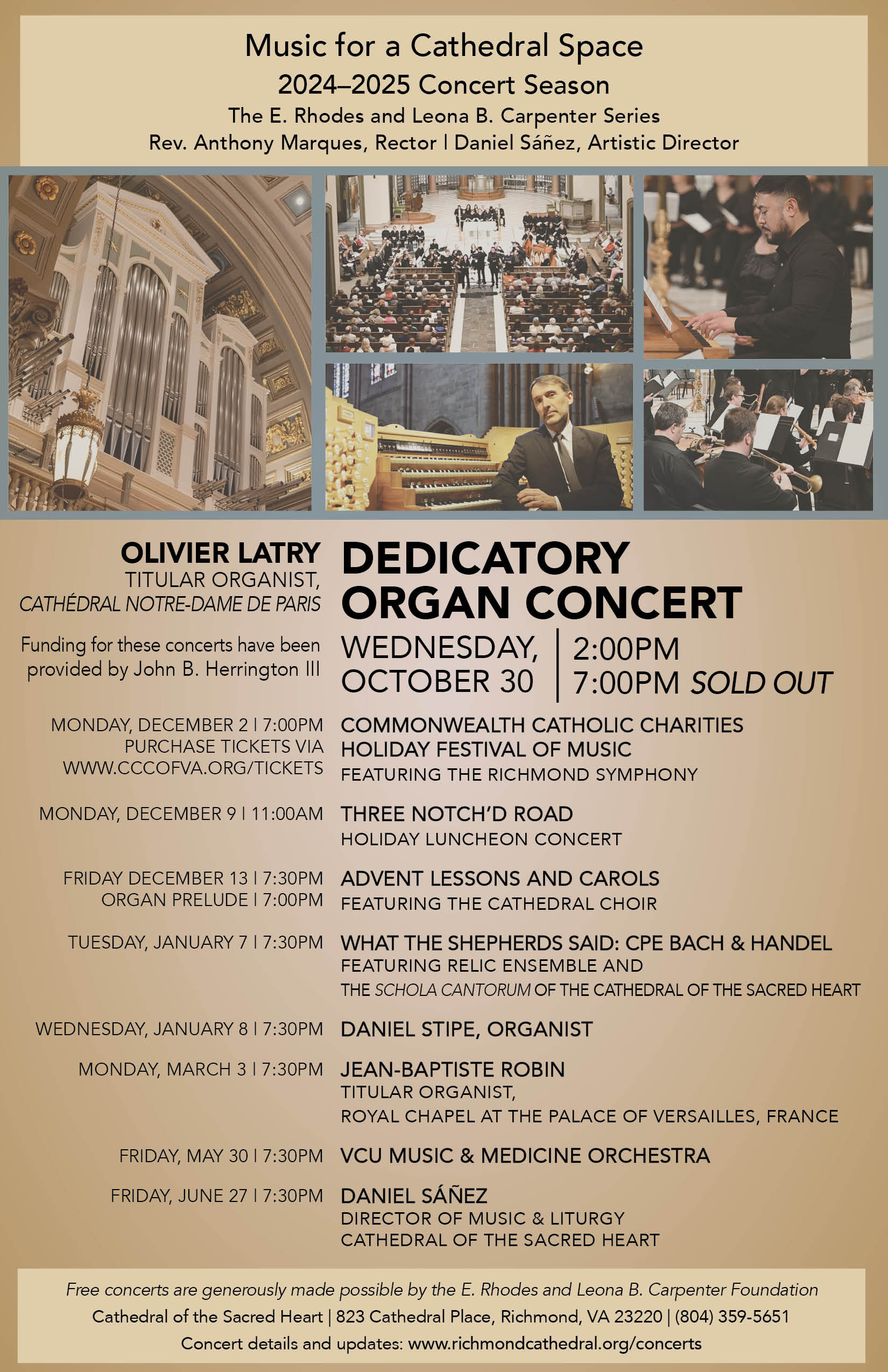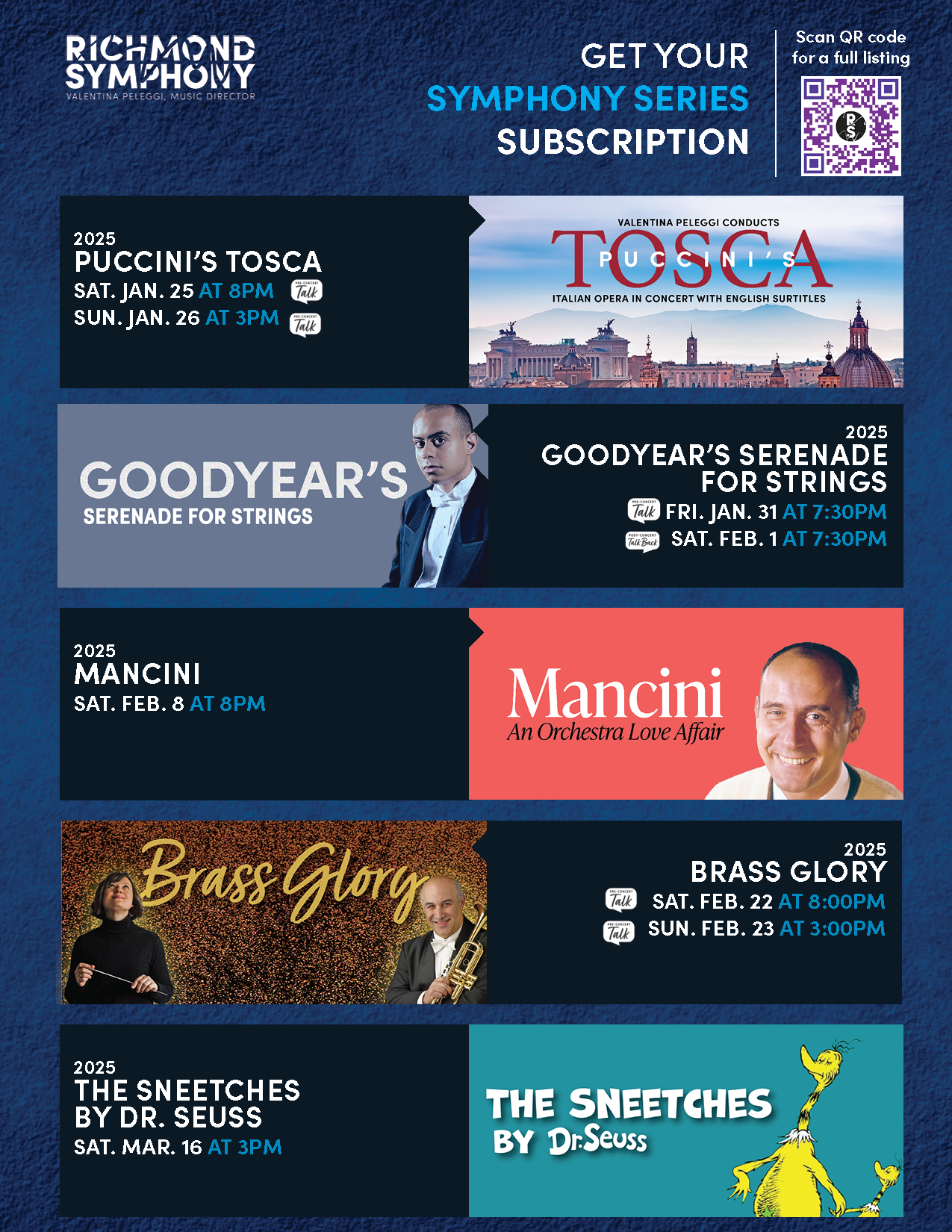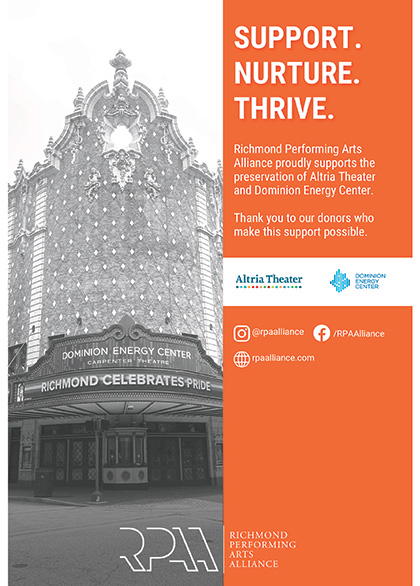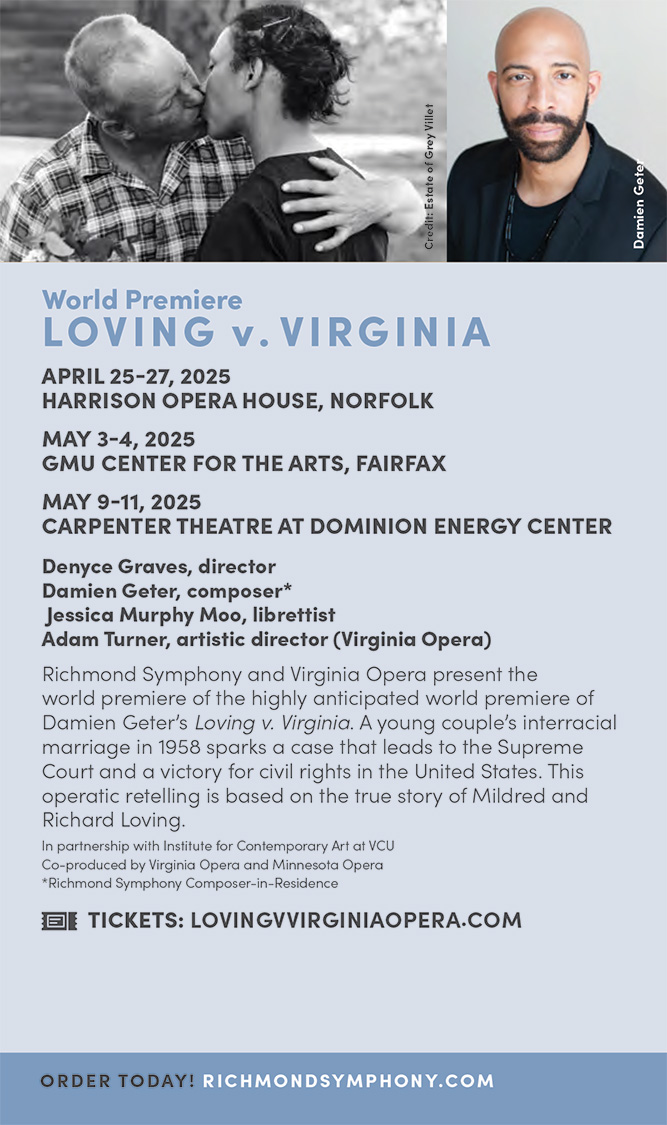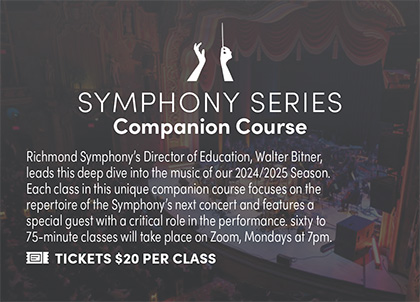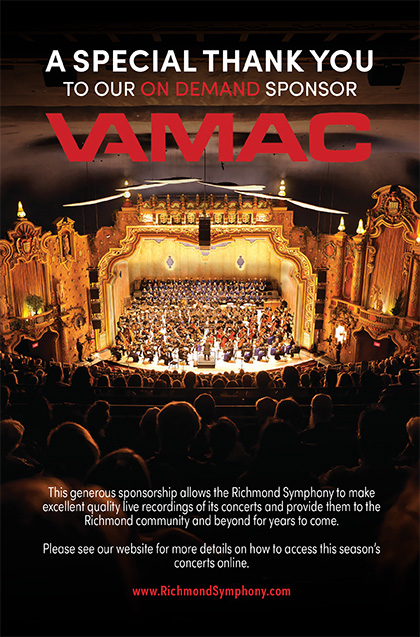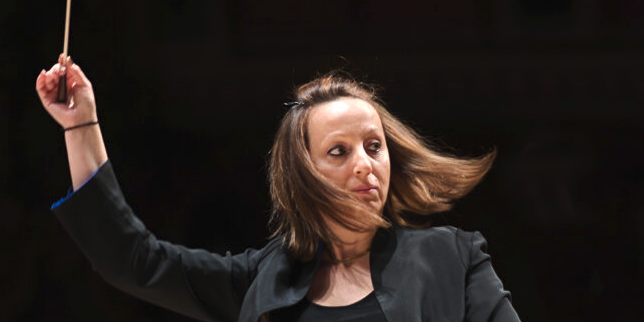
MOZART & MAHLER
Valentina Peleggi | Conductor
Kathryn Henry | SOPRANO
Joe Jaxson (b.2000) | Born In the Iron Grip (Inspired by Arthur Ashe) | |
Mozart (1756 - 1791) | Symphony No. 35 in D Major, K.385 “Haffner”
| |
INTERMISSION | ||
Mahler (1860-1911) | Symphony No. 4 in G Major | |
Last season, with Zachary Wadsworth’s Letter to the City, Music Director Valentina Peleggi inaugurated an annual series of Richmond Symphony commissions that showcase composers telling stories related to the city. She leads the orchestra in the world premiere of Born in the Iron Grip, Joe Jaxson’s commemoration of the 50th anniversary of Richmond native Arthur Ashe’s victory in the 1975 Wimbledon Championships. Ashe was just short of 32 when he triumphed at Wimbledon—the first Black man in history to win the Wimbledon singles title. Peleggi designed this program around the concept of youth. “Not only was Arthur Ashe young when he won the tournament, but he was an inspiration for younger generations,” she observes. “He created a lot of opportunities for young people to aspire and build something together.” The epitome of young genius—and, like Ashe, of a life cruelly foreshortened—Mozart naturally fits into the theme of youth. His “Haffner” Symphony bridges the composer’s early years in Salzburg with his rapidly development as a mature artist in Vienna. Meanwhile, in the movement that concludes his Symphony No. 4, Gustav Mahler offers a portrayal of heaven as seen through the eyes of a child.
Joseph Jaxson: Born in the Iron Grip
Currently earning his doctorate at the University of Texas in Austin, Joe Jaxson was born in New York in 2000 and moved with his family to Staunton, Virginia, at the age of two. He grew up in a household filled with the strains of smooth jazz, soul, R&B, and gospel, as well as Beethoven symphonies, about which his mother awakened his curiosity. Jaxson became a multi-instrumentalist, with a focus on the horn and trombone. As a composer and arranger, he writes for multiple media, including band, orchestra, and chamber music. A catalyst for his creative work, says Jaxson, is the desire to reach new audiences by conveying “programmatic experiences” that have the vividness of film and that are “accessible while complex in their own right.”
Lasting 13 minutes, Born In the Iron Grip takes its title from a passage in Arthur Ashe’s autobiography Days of Grace: “I am an African American, one born in the iron grip of legal segregation … my innermost stirrings inevitably have to do [with] trying to overcome racism and other forms of social injustice, with the search for dignity and power for Blacks in a world so often hostile to us.”
Scored for a large orchestra with expanded brass and percussion sections, the piece starts with an introductory characterization of Arthur Ashe (represented by a euphonium). The main theme, writes Jaxson, “passes through the solo trumpet, echoed by other members of the orchestra.” Following this introduction, “the piece moves forward to capture the setting of the Wimbledon Championship win in the Men’s Singles in 1975, facing off against Jimmy Connor.”
“We hear excitement, groove, jubilation,” writes Jaxson, “until interjections representing the common obstacles that are racism and injustice but that do not shake Arthur” enter the picture. “The match continues from the audience’s perspective until it rapidly switches to Arthur’s. A stark contrast, focusing on only the ball and his mind, attempting to outsmart and tire his opponent. In this moment, the piece begins its final section (‘Champion’), where we witness Arthur triumphantly coming out on top.” Jaxson alludes to the hymn “Lift Every Voice and Sing” to underscore “how Ashe’s talent in the tennis profession became a ‘voice’ for the African Americans of his generation and community. By using that talent against injustice, he inspired many future figures such as Serena Williams to become ‘voices’ for the Black community.”
Mozart: Symphony No. 35 in D major, K. 385 (“Haffner”)
It’s fascinating to trace the rapid evolution of Mozart’s conception of the symphony during his final decade. K. 385 in D major, widely known as the “Haffner,” represents a kind of bridge from the composer’s younger persona in his Salzburg years to the mature creative self of his years in Vienna.
In 1776, Mozart had been commissioned to compose a serenade for the wedding of the daughter of one of his hometown’s power brokers, a wealthy merchant named Sigmund Haffner. He produced an elaborate serenade that obviously left a lasting impression. When a ceremony conferring an aristocratic title Haffner’s son was to take place in 1782 (he was the same age as Mozart), the family wanted more music from the same source. Mozart’s father Leopold (a friend of the Haffners) asked him to produce a new, celebratory serenade.
But Mozart, by now resettled in Vienna as a freelancer, was overextended and unable to fulfill this particular request with his usual lightning speed. Heightening the tension was the fact that Mozart was preparing for his own wedding to Constanze Weber in August—a match not approved by Leopold, which caused considerable emotional pain for the composer.
Yet Mozart managed to produce one of his most sparkling orchestral works. The Symphony opens with a leap of joy: an infectious smile that spans two octaves and sets the spirited Allegro in motion. Mozart remarked to his father that it “must be played with great fire.” The second movement entertains with urbane pleasures—perhaps a nod to the composer’s new public in the big city. By contrast, the harmonic robustness of the Minuet recalls the festive, unforced mirth of his music for ceremonial celebrations from the earlier Salzburg years.
As a counterpart to the “great fire” of the first movement, Mozart asks for the finale be played “as fast as possible.” The main theme derives from one of the hit tunes from his first operatic success in Vienna, The Abduction from the Seraglio, but it foreshadows the spirit of another opera as well: the ebullient music of The Marriage of Figaro.
As he completed each movement, Mozart sent it back to his father in Salzburg—and then forgot about the project. The following spring, when he needed fresh material for one of his Vienna concerts, he looked the score over again and made some revisions, adding flutes and clarinets for the outer movements.
Writing to his father, Mozart observed that “my new ‘Haffner’ symphony has positively amazed me, for I had forgotten every single note of it. It must surely produce a good effect.” His prediction came true when the music was played at his Vienna concert in March 1783. A contemporary newspaper reported that among the “exceptionally large crowd” in attendance was the Emperor, who stayed for the whole concert “against his habit” and joined in “such unanimous applause as has never been heard of here.” Mozart seems to celebrate not only his Salzburg friends of old but the liberating prospects of his new life in Vienna.
Mahler: Symphony No. 4 in G major
In his first three symphonies, Gustav Mahler told stories that lead through tremendous struggle to transcendence, focusing on the human plane in the First and Second and, in the Third, on the cosmos itself, from which human consciousness emerges. The Fourth Symphony, by contrast, is the first symphonic journey to culminate in a gentle fade-out, renouncing the blazing affirmation with which his previous three had culminated. Despite the lofty ascent into Paradise, the music dies out deep in the bass—a “happy ending,” undoubtedly, yet one achieved without resolving the work’s strange juxtapositions.
As he had in so much else, Mahler went against the grain with an ironically childlike depiction of “the heavenly life.” This vision of Paradise—which sets a text from the folk poetry collection known in English as The Youth’s Magic Horn—is a strange one indeed, its portrait of heaven tied to well-known earthly joys of all-you-can eat feasts, endlessly flowing wine, and sensually appealing music. Mahler noted his attraction to the poem’s “mischievousness, combined with the deepest mysticism” where “everything is topsy-turvy.”
Although it serves as the destination, this orchestral song is where the Fourth Symphony originated. Mahler composed it as an independent song as early as 1892—he was especially fond of the piece and even recorded it on a piano roll—and at one point contemplated using it as the finale for the Third Symphony. (He even wove some phrase of the song into the fifth movement of the Third.) The first three movements of the Symphony No. 4 were composed between 1899 and early 1901. Mahler conducted the world premiere in Munich in November 1901 and continued to make revisions to the score.
Allusions to the Classical past in the first movement present a parallel to the naïveté of the childlike view of Paradise that is voiced in the song-finale. Mahler begins with the astonishing sound of sleigh bells and chirping flutes—as it to suggest that a musical fairy-tale is about to unfold, with ironic-nostalgic remembrances of what the symphony meant in the time of Mozart and his older friend Haydn.
The relatively lighter scoring allows us to savor the charm and pathos with which Mahler develops his ideas. The orchestra continually pokes, prods, and tweaks the material, revealing an almost absurd level of fertility in what are, after all, rather simple and straightforward themes. There is a newfound, almost neoclassical sensibility here that marks a change of attitude from the heaven-storming gestures of Mahler’s previous symphonies. The cultural historian Joseph Horowitz compares Mahler’s approach to surface detail here with the decorative elements of art nouveau—especially as found in the work of the composer’s contemporary Gustav Klimt, whose paintings negate the traditional hierarchy of foreground and background.
The Scherzo features a deliberately “mistuned” solo violin part meant to mimic a drunken rustic fiddler. A surreal, even macabre dimension complicates the image of all-is-for-the-best innocence that the finale’s Paradise seems to suggest. Mahler was said to have been inspired by a self-portrait by the Swiss artist Arnold Böcklin, in which Death appears as a skeleton fiddling into the painter’s ear.
A premonition of the lengthy Adagio is worked into the Scherzo, just as the Adagio foretells the final movement. Patterned as a set of double variations and inspired by the radiant quartet from Beethoven’s Fidelio, the Adagio combines a serene, “heavenly” perspective with the merely human (represented by the second, melancholy theme in the minor).
At the climax, Mahler evokes the equivalent of an out-of-body experience as the music subsides and sets the stage for the child’s song of the afterlife towards which everything has been heading. Song and symphony conclude with a gentle rocking motion that evaporates into silence.






